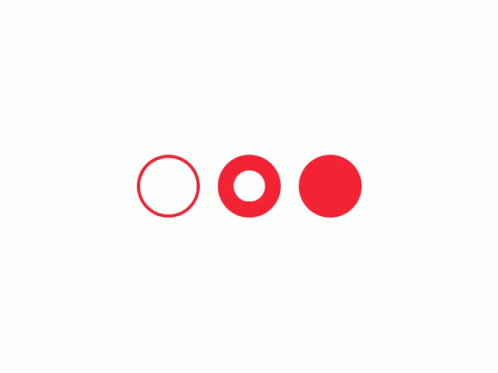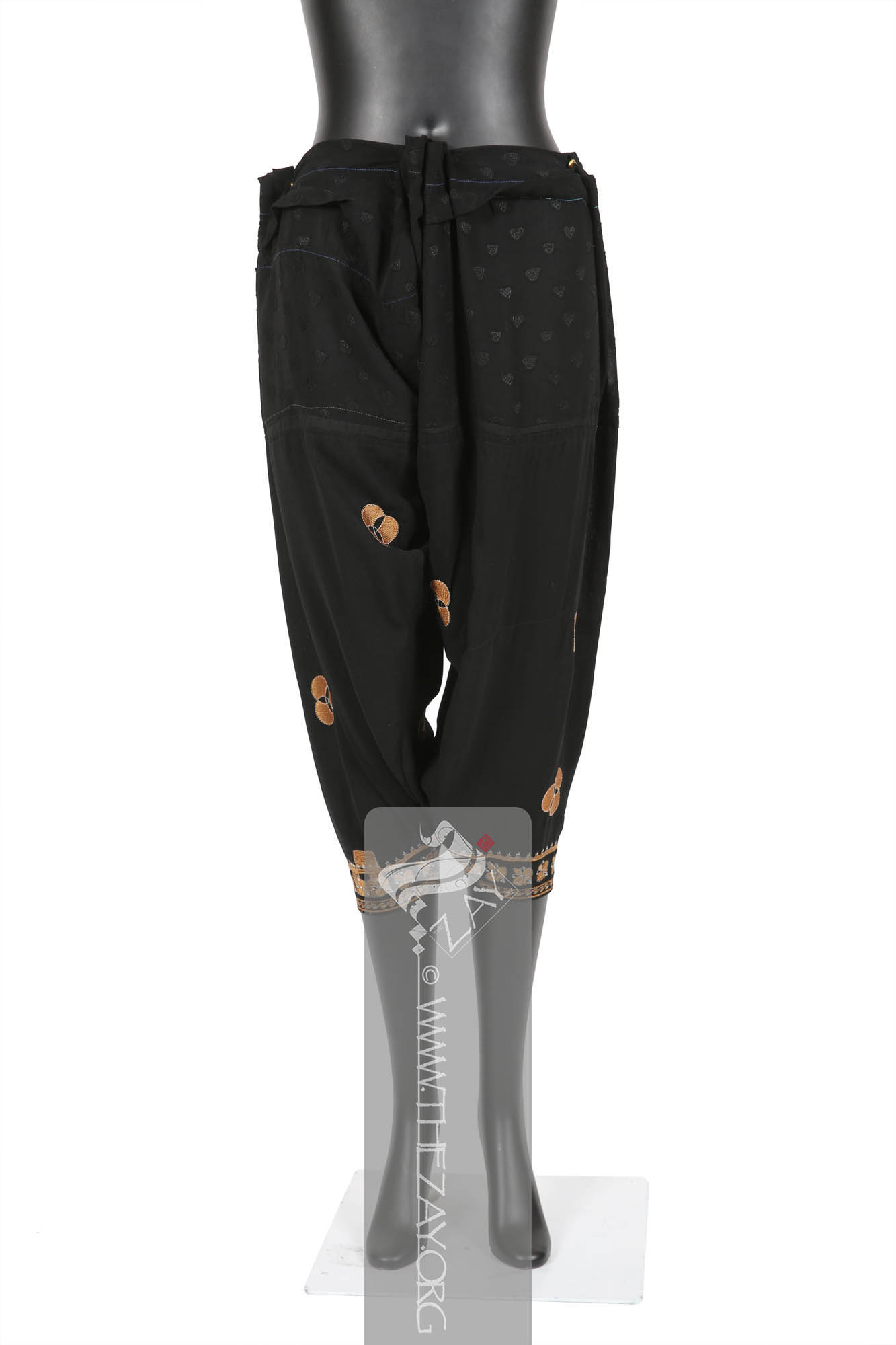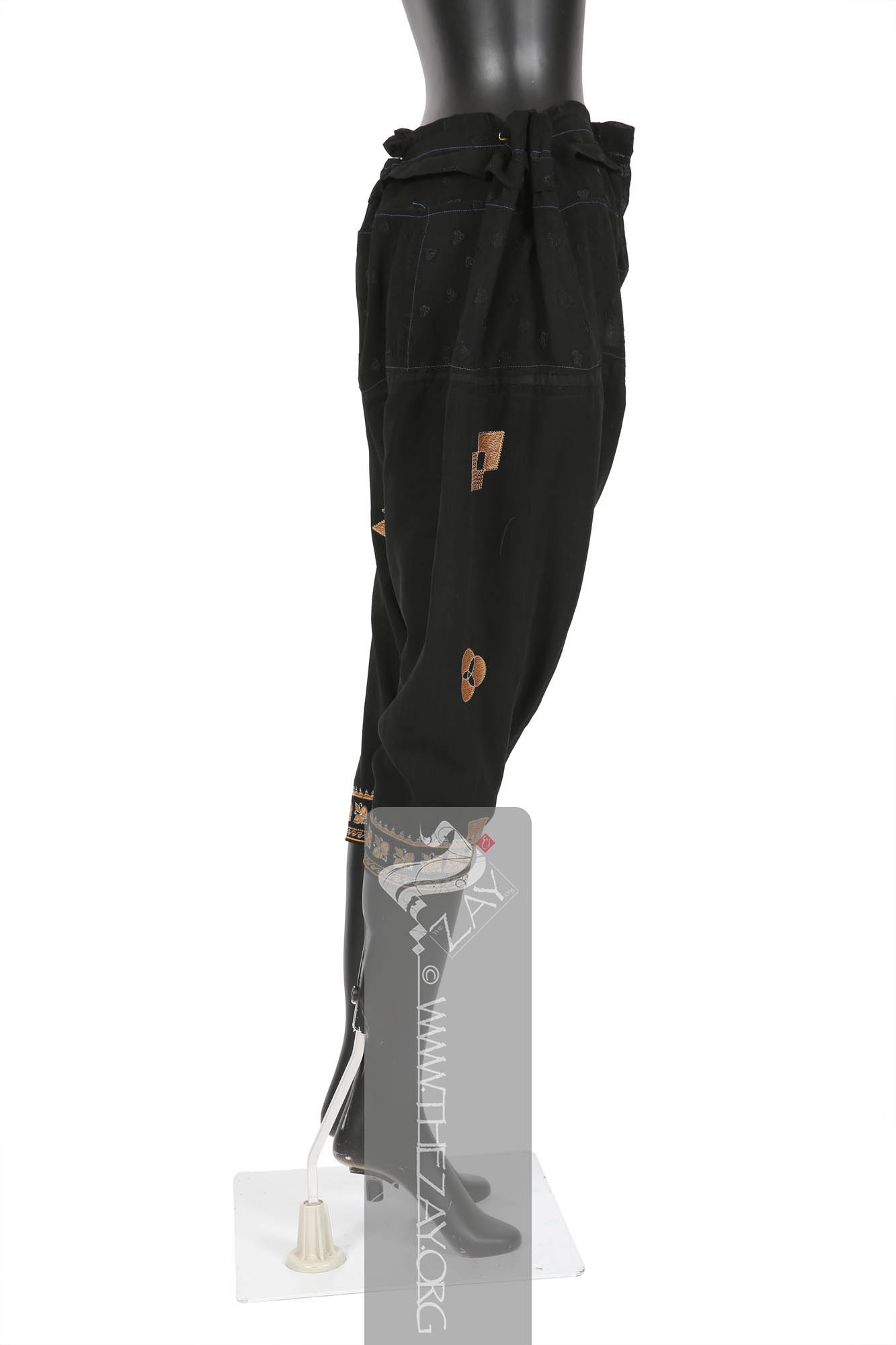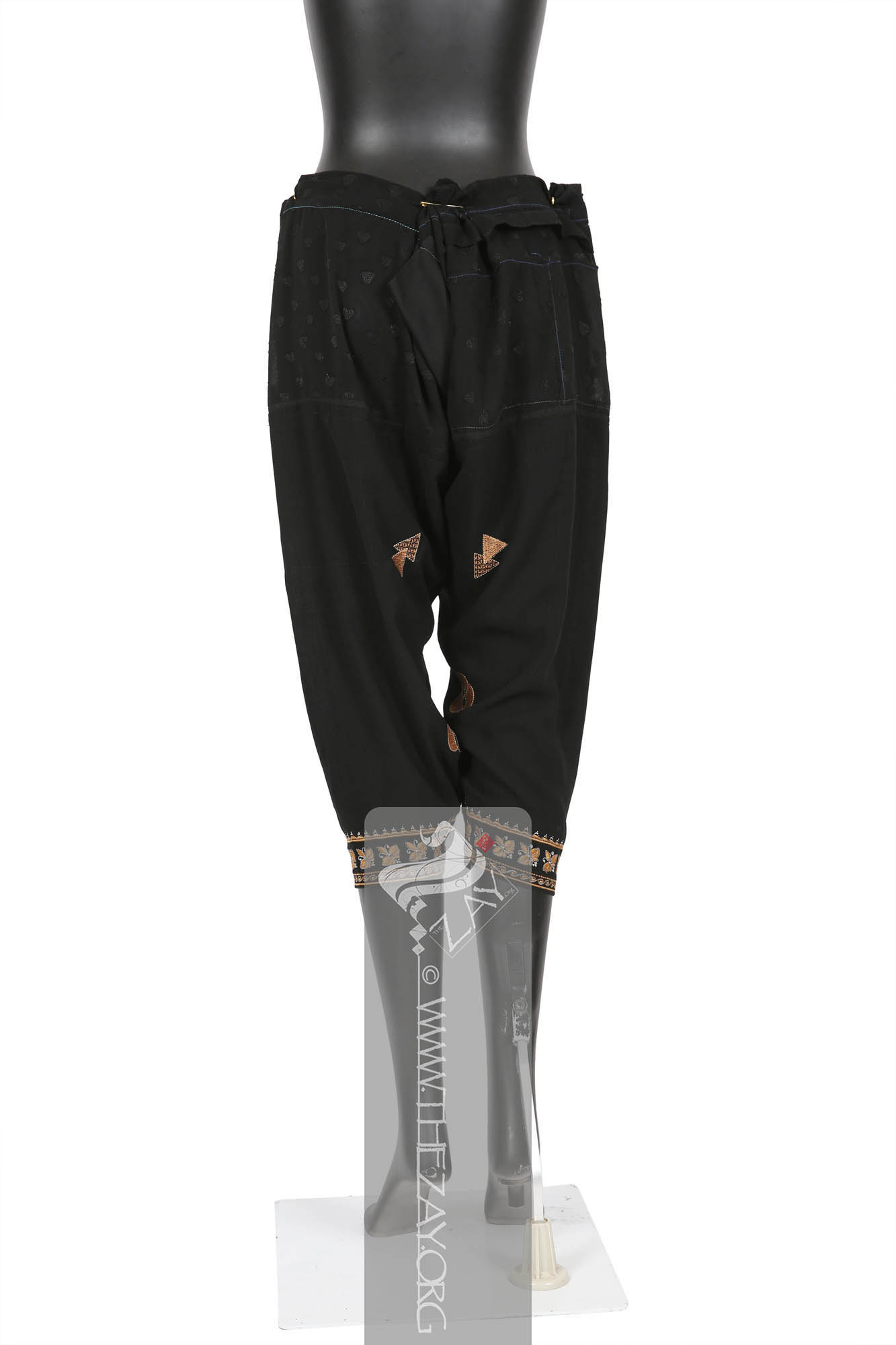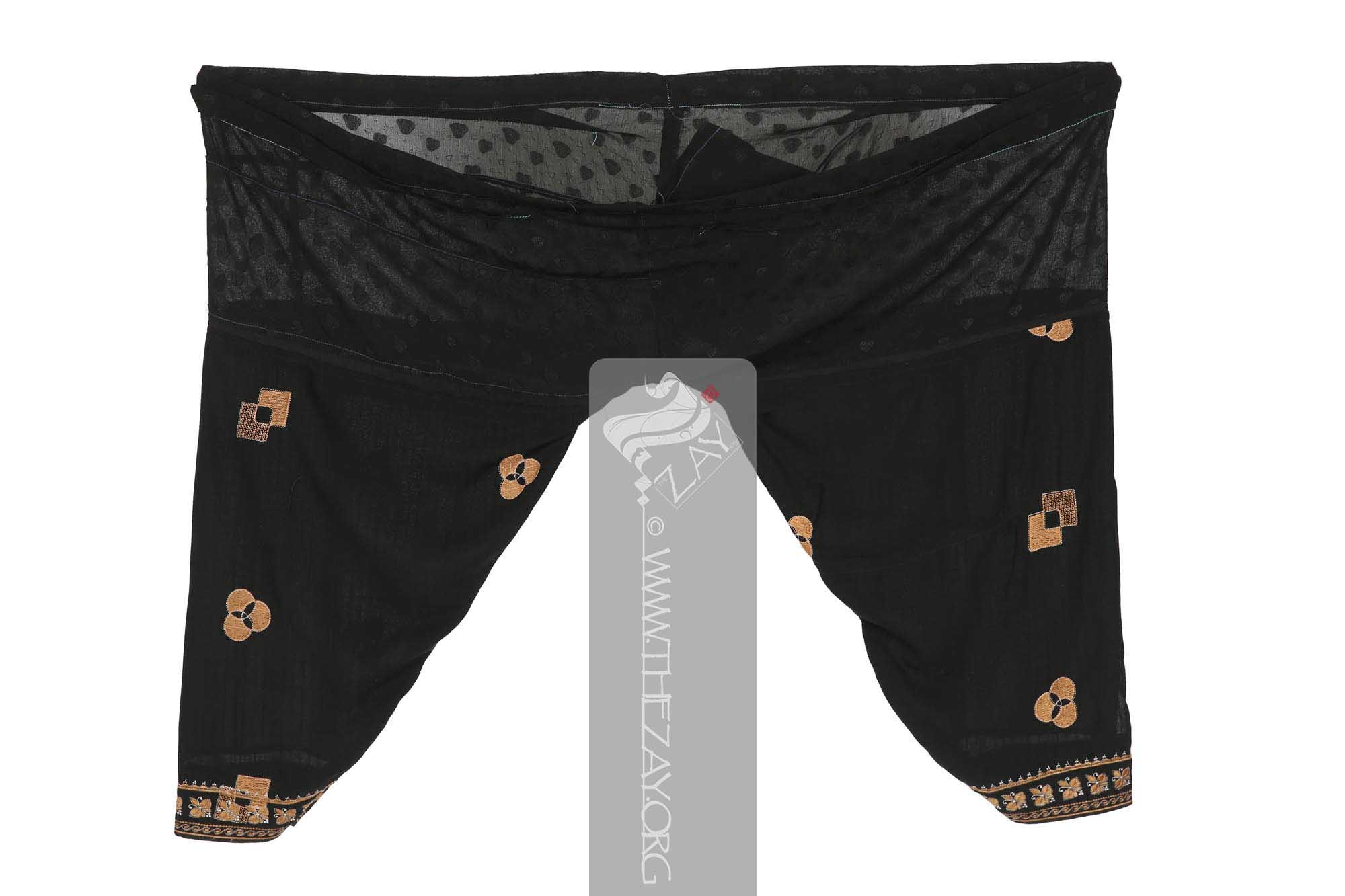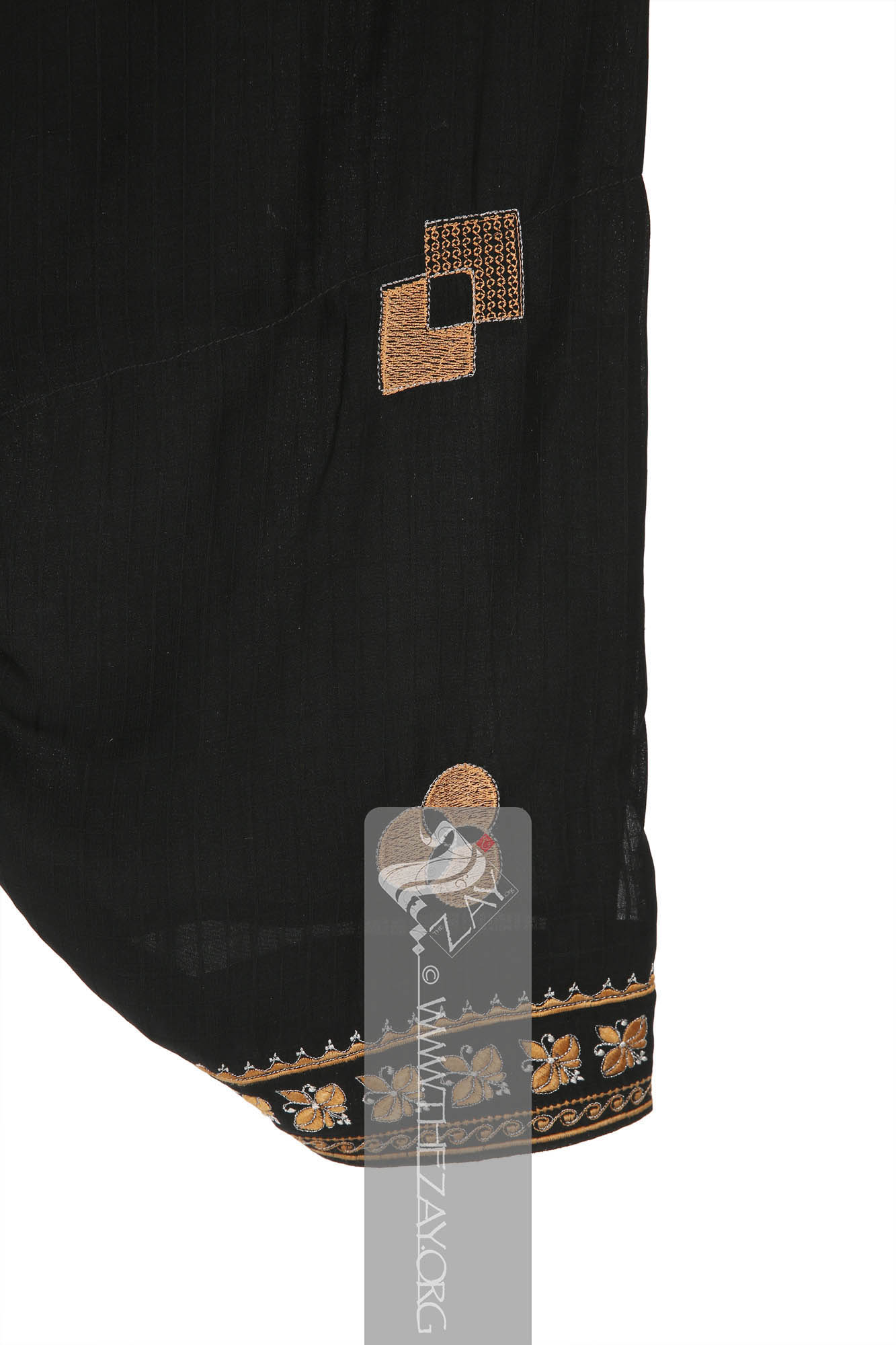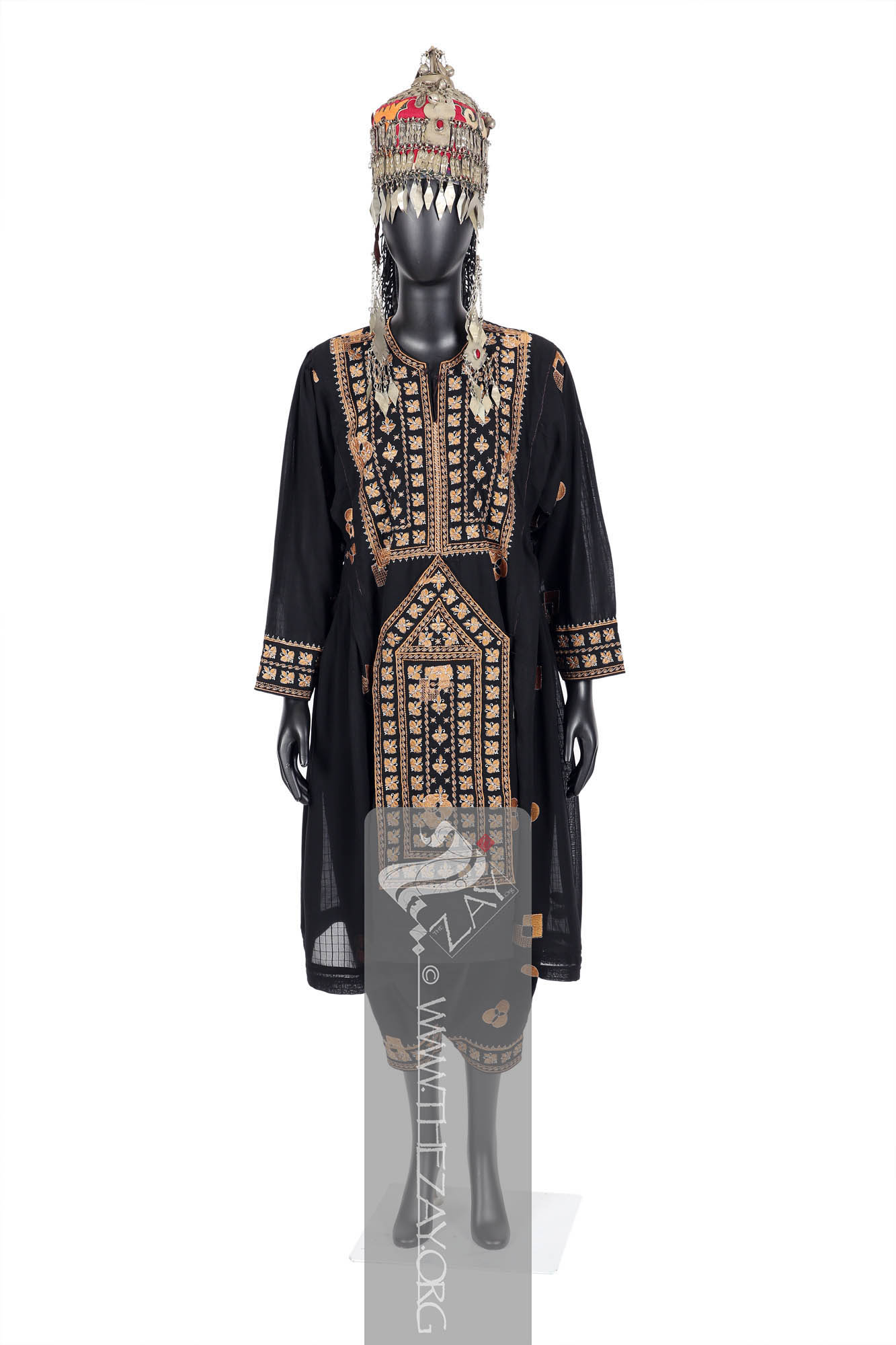Object NotePart of an ensemble consisting of three more items in the collection (
ZI2020.500734 ASIA,
ZI2020.500734b ASIA, and
ZI2020.500734c ASIA).
Object HistoryThis black pair of embroidered woman’s calf-length trousers native to the Balochi/Baluchi tribes native to Iran, Pakistan, Afghanistan, and India was purchased by
Dr. Reem Tariq
Ṭariq: (Arabic; Synonym: tulle_bi_talli
Tūlle_bi_tallī: (French: Tulle – a city in France where fine material for veil was first made; Turkish: tel – wire; Synonym: tariq; talli; badla; khus_dozi ), series of small metal knots made on a woven net ground as embellishment. The term is commonly used in the North African Arab region specifically in Egypt.
; talli; badla; khus_dozi ), series of small metal knots made on a woven net ground as embellishment. The term is commonly used in the Levant Arab region specifically in Lebanon.
El Mutwalli
Dr. Reem Tariq
Ṭariq: (Arabic; Synonym: tulle_bi_talli
Tūlle_bi_tallī: (French: Tulle – a city in France where fine material for veil was first made; Turkish: tel – wire; Synonym: tariq; talli; badla; khus_dozi ), series of small metal knots made on a woven net ground as embellishment. The term is commonly used in the North African Arab region specifically in Egypt.
; talli; badla; khus_dozi ), series of small metal knots made on a woven net ground as embellishment. The term is commonly used in the Levant Arab region specifically in Lebanon.
el Mutwallī: Founder (CEO) of the Zay
Zay: (Arabic: costume, Pl. azyaā’), a set of clothes in a style typical of a particular country or historical period. Initiative, a public figure, speaker and author. An expert curator and consultant in Islamic art and architecture, interior design, historic costume, and UAE heritage. from a dealer based in southern Iran, in 2020 to be added to The
Zay
Zay: (Arabic: costume, Pl. azyaā’), a set of clothes in a style typical of a particular country or historical period. Initiative collection. It was part of an ensemble along with a (
pashk
Pashk: (Persian: Posāk or Sanskrit Poshaka – Garment; from Sanskrit: Poshanam – To nurture), loose fitting calf length dress often worn over a pair of trousers similar to a South Asian kameez. ), accompanied by a necklace and a pair of earrings all of which are also part of the collection.
Object Features This is a pair of traditional Balochi women’s calf-length trousers or (
shalvar
shalvār: in Farsi, in the Emirati colloquial: ṣarwāl. In the Levantine colloquial: Shirwāl. Plural: sarāwīl, ṣarāwīl, sharāwīl, ṣarwīlāt). It is loose pants at the waist with folds, and narrow at the ankles. It is tied with a rope at the waist.)/(
salwar
Salwar: (Farsi: shalvār; Synonym: ṣarwāl, shirwāl ), trousers featuring tapering ankles and drawstring closure of Central Asian origin. They disseminated in the Indian subcontinent between c.1st-3rd century BCE. Although exact period of its arrival in the Arab world is disputed their widespread adoption is confirmed from the 12th century.
) in black silk (
georgette
Georgette: (French: Georgette de la Plante – a famous dressmaker), a lightweight, sheer fabric with a dull crimpled surface. It is usually made of silk but can also be made of synthetic fibers. Georgette was first introduced in the early 20th century and was named after the French dressmaker. ) with (
quadrille
Quadrille: (Latin: quadrum – square) Quadrille fabric is a type of lightweight cotton or linen fabric, woven with a checked or plaid pattern in contrasting colours. It is commonly used for clothing, drapery, and upholstery.
) style weave. It is embellished with typical Balochi style embroidery depicting geometric shapes and floral motifs and is typically worn with a tunic dress called (
kamiz
)/(
paskh
Paskh: (Persian: Posāk or Sanskrit Poshaka – Garment; from Sanskrit: Poshanam – To nurture), loose fitting calf length dress often worn over a pair of trousers similar to a South Asian kameez. )/(
pashk
Pashk: (Persian: Posāk or Sanskrit Poshaka – Garment; from Sanskrit: Poshanam – To nurture), loose fitting calf length dress often worn over a pair of trousers similar to a South Asian kameez. ).
The field of the trousers is embellished with sporadic repeats of interlaced geometric motifs – circles, and squares – executed in (
satin_stitch
Satin_stitch: (Synonym: Damask Stitch), is a type of flat embroidery stitch that creates a satin like smooth and shiny surface by closely spaced stitches, covering an entire area or shape.) style embroidery with silk
floss
Floss: (Old French: flosche – nap of velvet), is a type of silk fibre obtained from the cocoons of wild silkworms. It is characterized by its long, fluffy fibers that are not tightly woven, making it ideal for use in various textile applications such as embroidery, lace-making, and sewing. thread in mustard yellow reflecting the design of its accompanied
pashk
Pashk: (Persian: Posāk or Sanskrit Poshaka – Garment; from Sanskrit: Poshanam – To nurture), loose fitting calf length dress often worn over a pair of trousers similar to a South Asian kameez. . The borders of the trousers are also embellished with butterfly and floral motifs like the
pashk
Pashk: (Persian: Posāk or Sanskrit Poshaka – Garment; from Sanskrit: Poshanam – To nurture), loose fitting calf length dress often worn over a pair of trousers similar to a South Asian kameez. with outlines and highlights of silver metallic threads. It has a very wide waistband constructed of a
georgette
Georgette: (French: Georgette de la Plante – a famous dressmaker), a lightweight, sheer fabric with a dull crimpled surface. It is usually made of silk but can also be made of synthetic fibers. Georgette was first introduced in the early 20th century and was named after the French dressmaker. (
damask
Dāmāsk: (Arabic: Damascus – a city in Syria), is a luxurious fabric woven with reversible patterns typically in silk, wool, linen, or cotton. Originating in China, the fabric was perhaps introduced to European traders at Damascus – a major trading post on the Silk Road with a thriving local silk industry. ) fabric with repeats of heart-shaped motifs.
This piece possibly originated in the Sistan and Baluchestan province of Iran as it was accompanied by a necklace (
ZI2020.500734b ASIA) and a pair of earrings (
ZI2020.500734c ASIA) both of which are embellished with old nickel coins of Qajar Persian origin c. early 19th century.
Links
- Valérie Bérinstain, Mary Hunt Kahlenberg, Zaira Mis, Marcel Mis. Asian Costumes and Textiles from the Bosphorus to Fujiyama: The Zaira and Marcel Mis Collection. California: Skira, 2001.
- Suleman, Fahmida. Textiles of the Middle East and Central Asia (British Museum) The Fabric of Life. London: Thames and Hudson, 2017.
- Embroidery from Afghanistan Fabric, folios. Sheila Paine. Washington: University of Washington Press, 2006.
- Sukhareva, Olʹga Aleksandrovna. Suzani
Suzani: (Farsi: suzandozi : needlework, from Farsi: suzan: needle, dozi: embellishment), type of embroidered and decorative Central Asian tribal textile art usually on a cotton fabric, embroidered in both silk or cotton thread with primarily chain, satin, and buttonhole stitches as well as couching technique. : Central Asian Decorative Embroidery. Samarkand: SMI Asia, 2013.
- https://balochistanlovers.wordpress.com/2016/02/07/balochi-culture/
- https://www.pakpedia.pk/balochi-culture/
- https://www.encyclopedia.com/fashion/encyclopedias-almanacs-transcripts-and-maps/asia-central-history-dress
- https://referenceworks.brillonline.com/entries/encyclopaedia-iranica-online/clothing-COM_7759?lang=fr#COM-10186

